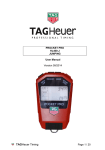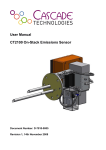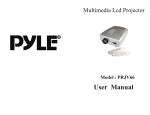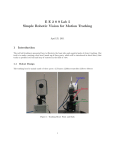Download User Manual - Wi-Chrono Wireless Timing System
Transcript
User Manual Last Update: January 11th, 2009 Version 1.0 Page 1 Thank you for choosing Agility In Motion Wi-Chrono. The Wi-Chrono wireless timer system was designed for ease of use and portability while preserving a rich feature set. The system consists of: ● 1 or more Station Set. Each set is composed by one Beam Emitter and one Receiver. The Emitter is responsible for sending a beam of infrared waves to the receiver. The infrared light is invisible to human eye, and harmless to animals and persons, it uses the same technology as TV remote controls. The Receiver is equipped with a beam waves sensor and detects any interruption in the path of light, sending a wireless notification to the Base unit. This notification will be interpreted as an indication that an object has crossed the infrared link between the Emitter and the Receiver. No configuration of any kind is required for operation of the beam emitter and receiver set. ● A Base unit that is responsible for displaying the elapsed time and interpreting the signals sent by the Station Sets. The base unit acts as console for the system, providing partial times, and allowing to interchange between partial times and accumulated times. The only configuration input to the base unit is a small knob to adjust how many partial times you want to account for. Version 1.0 Page 2 1 Packing list - Base unit: Pict. 1: Base Unit - Station Set. The set is composed by 2 small boxes, one is the receiver and one is the emitter. Depending on the configuration of the equipment you acquired, you may have more than 1 set, the system supports up to 8 sets. Receiver and Emitter boxes are equipped with their respective Elastic Velcro tie. Pict. 2: Start-Split-Stop Version 1.0 Pict. 3: Beam Emitter Page 3 2 Installing the stations Install each Receiver and Emitter set with the LEDs facing each other, and with their back flat against their mounted equipment. The height depends on how high your dog jumps over the bars, but as a general rule, the set may be installed about 10 inches over the bar (or 25 cm). Both the receiver and the emitter are equipped with Velcro® tape and Elastic Velcro tie for easy installation on virtually any surface or equipment. 2.1 Installing on a jump stand Unwrap the Velcro tie and wrap it around the jump stand at the proper height. Install the receiver and emitter boxes with their back flat against the stands for stability. Version 1.0 Page 4 2.2 Installing the station set on a flat surface Apply a small piece of adhesive Velcro to your equipment at the desired height. Take away the elastic Velcro tie from the receiver and press the back of the receiver box against the Velcro applied on the equipment. Do the same with the emitter. 2.3 Other ideas You may build your own set of PVC stands that will allow you to easily slide the station boxes up and down a for quick change of heights. Remember to install the receiver and emitter with their back flat against the stands for stability. Or you may use magnets with Velcro to attach the set to metallic jumps. Or you may use tripods. Version 1.0 Page 5 3 Proper Alignment of the Station Set Install each Receiver and Emitter set with the LED lights facing each other. The height at which to install the set depends on how high your dog jumps over the bars, but as a general rule, the set may be installed about 10 inches over the bar (25 cm). If you are using 2 or more sets at the same time, make sure to point the emitters across from each other so the beam of infrared light of one set is only sensed by its receiver and not detected by the other stations too. Version 1.0 Page 6 4 Beam Emitter 4.1 LEDs and IR transmitter The top two clear lights are the infrared LED emitters. The bottom LED is the On/Off indicator. The two infrared LED emitters are very low power devices and completely harmless for dogs and humans, and they use the same technology as a regular TV remote control. Version 1.0 Page 7 5 Receiver 5.1 LEDs and IR reception sensor The orifice allows the reception of the infrared light emitted by the beamer while insulating the sensor from direct sunlight exposure. The bottom LED indicates the unit is powered on, the top 3-LEDs show the strength of the signal received from the IR transmitter. Fig. 1: Receiver's lateral view Version 1.0 Page 8 5.2 LED status description When the “Power Switch” in the “Off” position as indicated in Fig.2, you would observe that no LEDs are lit, as shown in Fig.1. Fig. 2: Power switch in OFF position When you turn the device on, and provided that the batteries are installed and charged, you will observe one of the following: Fig. 3: a) Unit is ON - not able to "see" the Emitter Version 1.0 Page 9 The Beam Emitter and the Station are carefully designed and calibrated so they don't need to be perfectly aligned, allowing a misalignment of about 10 degrees from a perfect alignment. Where perfect alignment is the Beam Emitter's IR pointing straight to the Station (or “Start-SplitStop”) own IR sensor. Pict. 4: "Start-Split-Stop" & "Beam Emitter" perfectly aligned However, in some circumstances, either the vertical alignment (the “Start-Split-Stop” and the “Beam Emitter” are one higher than the other) or the directional alignment (the “Start-Split-Stop” and the “Beam Emitter” are not 'facing' each other, but they are at an angle), in such situations, the “Link Quality” LEDs will show: Version 1.0 Page 10 Fig. 4: Yellow also turned on, alignment is not perfect Fig. 5: IR signal too weak, review alignment Version 1.0 Page 11 6 Base Unit The “Base Unit” is the brain of the system, it processes the signals sent by the “Start-Split-Stop” every time an object breaks the beam transmitted by the “Beam Emitter”. Pict. 5: Base Unit - Main components The Base Unit has only 1 configuration component, the “Split Enabler” which tells the system how many splits are in a single run, in order to stop the clock. The “Manual Stop” button allows to manually stop a run once started, or changes the “Display” between partial times and total accumulated times. Version 1.0 Page 12 6.1 Choosing a value for “Split Enabler” Pict. 6: Split Enabler set to 3 The “Split Enabler” tells the system how many segments, or partial times, are required to stop the clock. The stopwatch is always activated by the first beam that is interrupted, then it will stop depending on the configuration of the “Split Enabler” Please refer to the following table for details on how the configuration of the “Split Enabler” affects the number of split times that will be considered by the system. Version 1.0 Page 13 Pict. 7: Effect of "Split Enabler" on number of splits to consider As an example, assume that the “Split Enabler” is set to 3, as it is depicted in “Pict. 5', the following events will occur: – – – – The first beam is crossed and the clock is started Next beam is crossed 3.89” later, and the accumulated time is stored for split #1 Next beam is crossed, and the accumulated time is stored for split #2 (for example, if the time between crossing the 1st beam and the 3rd beam is 8.13”, then the accumulated time for split 2, will be 8.13 Next a beam is crossed at time 13.85”, and being the 3rd beam crossed after the clock started, the stopwatch is stopped Version 1.0 Page 14 6.2 Changing the view between “partial” and “total” times After a run is completed, either by crossing beams enough times or by pressing “Manual Stop”, you can switch between “partial” and total times view. In “total” times view, the times are expressed as the accumulated times since the start of the run, whereas in “partial” times view, the times are expressed as the difference with respect to the previous lap. For example, given the same run as in “6.1 Choosing value for Split Enabler”, which we refresh here : Fig. 6: A run with 3 splits - Accumulated Times view When switching to “Partial Times” view, you'd see : Fig. 7: A run with 3 splits - Partial Times view You can switch views as many times as you wish. Version 1.0 Page 15 7 Troubleshooting and common symptoms For all components of the system, the “Beam Emitter”, the “Start-SplitStop” or the “Base Unit” the main reason for malfunction is low battery. Please contact us at [email protected] if you have questions. 7.1 “Beam Emitter” Symptom: The “power” LED is not on Possible reasons and suggested actions: • The batteries are drained, try replacing the batteries • The batteries polarity is reversed, follow the drawings in the battery holder 7.2 “Start-Split-Stop” Symptom: The “power” LED is not on Possible reasons and suggested actions: • The batteries are drained, try replacing the batteries • The batteries polarity is reversed, follow the drawings in the battery holder Symptom: The “Start-Split-Stop” is unable to 'see' the beam from the “Beam Emitter” Possible reasons and suggested actions: • If no “Link Quality” LED is ON, then the units might be seriously misaligned, try realigning them • If the alignment is correct, but still no link is detected, try with another “Beam Emitter”. Symptom: The “Start-Split-Stop” detects the broken beam, but it Version 1.0 Page 16 does not signal the “Base” unit Possible reasons and suggested actions: • If you see the 3 “Link Quality” LEDs lit for a few seconds every time you break the beam, but still you don't see the base acting upon it, try replacing the batteries in the “Start-Split-Stop” 7.3 “Base Unit” Symptom: The “display” remains blank after switch on Possible reasons and suggested actions: • The batteries are drained, try replacing the batteries • The batteries polarity is reversed, follow the drawings in the battery holder Symptom: The “Base Unit” does not recognize a broken- beam event Possible reasons and suggested actions: • Version 1.0 See The “Start-Split-Stop” is unable to 'see' the beam from the “Beam Emitter” Page 17 8 Frequently Asked Questions • Question: I want to add another “Start-Split-Stop” and “Beam Emitter”, is it possible ? Do I need to give you a code or anything ? Answer: Yes, you can add up to 8. All the “Beam Emitter” are the same amongst them and also the “Start-Split-Stop”, so there is no need to inform us of any code or frequency, since they are all exactly the same. • Question: My friends have a “Agility In Motion Wi-Chrono” also, can I use their “Start-Split-Stop” and “Beam Emitters” ? Answer: Yes, you can. The “Base Unit” is not restricted to a set of components, they are all the same and can be shared. • Question: I have 2 sets of “Agility In Motion Wi-Chrono” but noticed that when I used them together, they get activated at the same time ? Answer: Yes, that is correct. If you plan to use both systems at the same time, but want to preserve their independence, we can reprogram them. Please contact us. • Question: What is the accuracy of the system ? Answer: The system runs with a high precision clock with a specified accuracy of 50 PPM, (it is off, at most, by 50 'ticks' per millions), which actually depends on several physical factors, like temperature. Expect the system to run about 1/100” plus or minus per minute. • Question: I compared my system to my friends system, we both were using the same start and stop, but the times are off by 1/100, but only sometimes ? Answer: The source clock is very accurate, but many factors affect the time processing, the most important one being that is “interrupt driven”. When a beam event happen, the system “gets interrupted” at a 1/100” boundary, that's why 2 systems might “look” off by 1/100. Version 1.0 Page 18 9 Technical specifications • FCC ID:OUR-XBEE • “Start-Split-Stop” to “Base” Range : Up to 100m (110y) with line of sight (wireless) • “Beam Emitter” to “Start-Split-Stop” Range: Up to 5m (IR) • Operating Temperature : 0 to 45 degree Celsius Version 1.0 Page 19






























